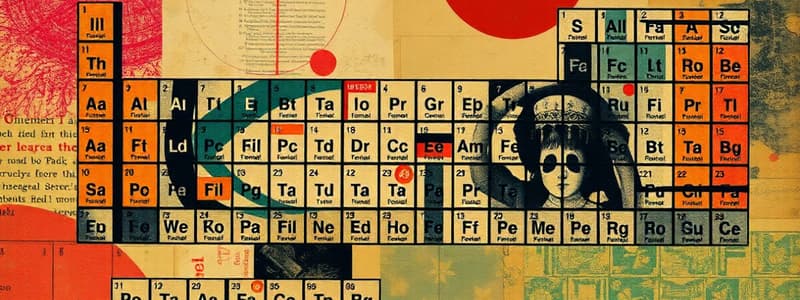Podcast
Questions and Answers
What is the periodic law based on?
What is the periodic law based on?
- Increasing atomic number and chemical properties (correct)
- Decreasing atomic mass and physical properties
- Increasing atomic mass and chemical properties
- Decreasing atomic number and similar mass numbers
Which elements are part of the same grouping characterized by high reactivity?
Which elements are part of the same grouping characterized by high reactivity?
- Boron, silicon, germanium
- Calcium, strontium, barium
- Fluorine, chlorine, bromine
- Lithium, sodium, potassium (correct)
What distinguishes isotopes of an element?
What distinguishes isotopes of an element?
- Different atomic masses and the same atomic number (correct)
- Identical mass and atomic numbers
- Different atomic numbers and the same mass number
- Different chemical properties and atomic mass
What characteristic do all metals generally share?
What characteristic do all metals generally share?
Which two scientists are credited with the early classification of the periodic table?
Which two scientists are credited with the early classification of the periodic table?
Why did Mendeleev's periodic table stand out from Meyer's?
Why did Mendeleev's periodic table stand out from Meyer's?
Which of the following groups demonstrates similar chemical properties?
Which of the following groups demonstrates similar chemical properties?
What property distinguishes nonmetals from metals on the periodic table?
What property distinguishes nonmetals from metals on the periodic table?
Which statement accurately describes the state of non-metals at room temperature?
Which statement accurately describes the state of non-metals at room temperature?
What property is NOT characteristic of metals?
What property is NOT characteristic of metals?
What is the primary difference between metals and non-metals based on their physical properties?
What is the primary difference between metals and non-metals based on their physical properties?
Which of the following statements about metalloids is TRUE?
Which of the following statements about metalloids is TRUE?
How are elements organized within the periodic table's groups?
How are elements organized within the periodic table's groups?
What does AMU stand for?
What does AMU stand for?
What is true about the mass of one proton?
What is true about the mass of one proton?
How do you calculate the number of neutrons in an element?
How do you calculate the number of neutrons in an element?
Which of the following symbols represents a noble gas?
Which of the following symbols represents a noble gas?
What distinguishes valence electrons from other electrons?
What distinguishes valence electrons from other electrons?
Which element is a liquid at room temperature?
Which element is a liquid at room temperature?
In the periodic table, what state of matter do most metals belong to?
In the periodic table, what state of matter do most metals belong to?
What is the atomic number used to find?
What is the atomic number used to find?
What discovery provided significant support for Mendeleev’s work?
What discovery provided significant support for Mendeleev’s work?
What is the modern interpretation of the periodic law?
What is the modern interpretation of the periodic law?
What does the atomic number represent?
What does the atomic number represent?
If an element has an atomic mass of 11 and 5 protons, how many neutrons does it have?
If an element has an atomic mass of 11 and 5 protons, how many neutrons does it have?
Which of the following statements is true about isotopes?
Which of the following statements is true about isotopes?
Which element has an atomic number of 1?
Which element has an atomic number of 1?
How is atomic mass calculated?
How is atomic mass calculated?
Which of the following elements is organized vertically in the periodic table based on similar properties?
Which of the following elements is organized vertically in the periodic table based on similar properties?
Which group of elements is known for having a single valence electron and high reactivity?
Which group of elements is known for having a single valence electron and high reactivity?
What is a key characteristic of alkaline earth metals?
What is a key characteristic of alkaline earth metals?
What is the rule of octet related to atomic bonding?
What is the rule of octet related to atomic bonding?
Which of the following elements is hydrogen classified with?
Which of the following elements is hydrogen classified with?
Why are alkali metals never found as free elements in nature?
Why are alkali metals never found as free elements in nature?
How many protons and electrons does a hydrogen atom have?
How many protons and electrons does a hydrogen atom have?
What kind of elements are located in the columns labeled 3-12 on the periodic table?
What kind of elements are located in the columns labeled 3-12 on the periodic table?
What do atoms with 6, 7, or 8 valence electrons typically do during bonding?
What do atoms with 6, 7, or 8 valence electrons typically do during bonding?
Flashcards are hidden until you start studying
Study Notes
Essential Learning Competencies
- Differentiate between atomic number, mass number, and isotopes.
- Identify elements based on their distinguishing features.
Learning Objectives
- Understand the periodic law and element organization in the periodic table.
- Predict properties of elements based on their periodic table location.
- Classify metals, nonmetals, and metalloids by properties and placement.
Historical Context
- Early chemists grouped elements by similar behaviors; examples include:
- Li, Na, K: reactive, shiny, good conductors.
- Ca, Sr, Ba: less reactive, also shiny and conductive.
- Dimitri Mendeleev (1869) and Lothar Meyer (1870) organized elements by increasing atomic mass and recognized periodic relationships.
- Mendeleev predicted undiscovered elements (e.g., gallium, germanium) based on his table, gaining support for his work.
Modern Periodic Law
- Modern periodic law states that element properties are periodic functions of atomic numbers, not masses.
- The periodic table is arranged by increasing atomic numbers, grouping similar properties in vertical columns.
Understanding the Periodic Table
- Atomic Number: Number of protons in an element; unique to each element.
- Atomic Mass: Sum of protons and neutrons; represents the weight of the atom.
- Isotopes: Atoms with identical protons but differing neutrons.
Chemical Symbols
- Each element has a unique symbol, either a single capital letter or a combination of capital and lowercase letters.
States of Matter
- Most metals (except Hg) are solids; some are softer (e.g., Li, Na) while others are harder (e.g., Cu, Fe).
- Nonmetals predominantly exist as gases; exceptions include solid forms like sulfur and phosphorus.
- Metalloids exhibit properties of both metals and nonmetals.
Classification of Elements
- Metals:
- Good conductors of heat/electricity, shiny, ductile, and malleable.
- Reactive, especially with water.
- Nonmetals:
- Poor conductors, brittle if solid, dull appearance, often gaseous.
- Metalloids:
- Intermediate properties, can be shiny or dull, better conductors than nonmetals but less than metals.
Periods and Groups
- Elements are arranged in:
- Horizontal Rows (Periods): No similar property correlation.
- Vertical Columns (Groups/Families): Similar properties among elements in the same column.
Specific Groups in the Periodic Table
- The periodic table includes:
- Main-group elements (columns 1, 2, 13-18).
- Transition metals (columns 3-12).
- Inner transition metals (lanthanides and actinides).
Alkali Metals
- Located in Group 1, characterized by:
- Shiny appearance, clay-like consistency, and softness.
- Highly reactive, especially with water; not found uncombined in nature.
Alkaline Earth Metals
- Found in Group 2:
- Have two valence electrons, including magnesium and calcium.
- Also reactive, but less so than alkali metals; not found uncombined in nature.
Reactivity Concepts
- Reactivity relates to incomplete valence electron levels; atoms achieve stability by completing their outer shells.
- Atoms with fewer valence electrons tend to lose them; those with 6, 7, or 8 gain during bonding.
Studying That Suits You
Use AI to generate personalized quizzes and flashcards to suit your learning preferences.




